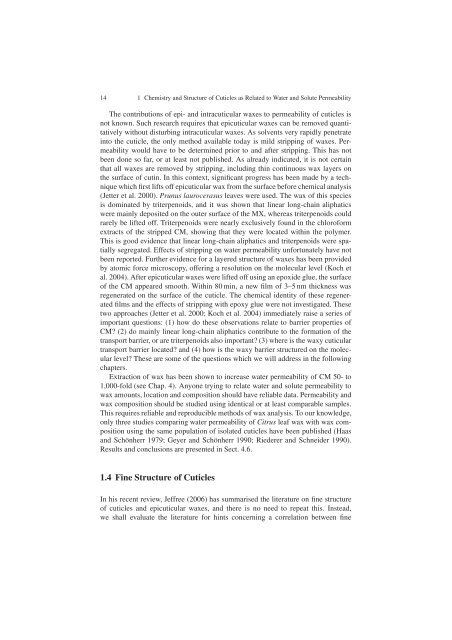Water and Solute Permeability of Plant Cuticles: Measurement and ...
Water and Solute Permeability of Plant Cuticles: Measurement and ...
Water and Solute Permeability of Plant Cuticles: Measurement and ...
Create successful ePaper yourself
Turn your PDF publications into a flip-book with our unique Google optimized e-Paper software.
14 1 Chemistry <strong>and</strong> Structure <strong>of</strong> <strong>Cuticles</strong> as Related to <strong>Water</strong> <strong>and</strong> <strong>Solute</strong> <strong>Permeability</strong><br />
The contributions <strong>of</strong> epi- <strong>and</strong> intracuticular waxes to permeability <strong>of</strong> cuticles is<br />
not known. Such research requires that epicuticular waxes can be removed quantitatively<br />
without disturbing intracuticular waxes. As solvents very rapidly penetrate<br />
into the cuticle, the only method available today is mild stripping <strong>of</strong> waxes. <strong>Permeability</strong><br />
would have to be determined prior to <strong>and</strong> after stripping. This has not<br />
been done so far, or at least not published. As already indicated, it is not certain<br />
that all waxes are removed by stripping, including thin continuous wax layers on<br />
the surface <strong>of</strong> cutin. In this context, significant progress has been made by a technique<br />
which first lifts <strong>of</strong>f epicuticular wax from the surface before chemical analysis<br />
(Jetter et al. 2000). Prunus laurocerasus leaves were used. The wax <strong>of</strong> this species<br />
is dominated by triterpenoids, <strong>and</strong> it was shown that linear long-chain aliphatics<br />
were mainly deposited on the outer surface <strong>of</strong> the MX, whereas triterpenoids could<br />
rarely be lifted <strong>of</strong>f. Triterpenoids were nearly exclusively found in the chlor<strong>of</strong>orm<br />
extracts <strong>of</strong> the stripped CM, showing that they were located within the polymer.<br />
This is good evidence that linear long-chain aliphatics <strong>and</strong> triterpenoids were spatially<br />
segregated. Effects <strong>of</strong> stripping on water permeability unfortunately have not<br />
been reported. Further evidence for a layered structure <strong>of</strong> waxes has been provided<br />
by atomic force microscopy, <strong>of</strong>fering a resolution on the molecular level (Koch et<br />
al. 2004). After epicuticular waxes were lifted <strong>of</strong>f using an epoxide glue, the surface<br />
<strong>of</strong> the CM appeared smooth. Within 80 min, a new film <strong>of</strong> 3–5 nm thickness was<br />
regenerated on the surface <strong>of</strong> the cuticle. The chemical identity <strong>of</strong> these regenerated<br />
films <strong>and</strong> the effects <strong>of</strong> stripping with epoxy glue were not investigated. These<br />
two approaches (Jetter et al. 2000; Koch et al. 2004) immediately raise a series <strong>of</strong><br />
important questions: (1) how do these observations relate to barrier properties <strong>of</strong><br />
CM? (2) do mainly linear long-chain aliphatics contribute to the formation <strong>of</strong> the<br />
transport barrier, or are triterpenoids also important? (3) where is the waxy cuticular<br />
transport barrier located? <strong>and</strong> (4) how is the waxy barrier structured on the molecular<br />
level? These are some <strong>of</strong> the questions which we will address in the following<br />
chapters.<br />
Extraction <strong>of</strong> wax has been shown to increase water permeability <strong>of</strong> CM 50- to<br />
1,000-fold (see Chap. 4). Anyone trying to relate water <strong>and</strong> solute permeability to<br />
wax amounts, location <strong>and</strong> composition should have reliable data. <strong>Permeability</strong> <strong>and</strong><br />
wax composition should be studied using identical or at least comparable samples.<br />
This requires reliable <strong>and</strong> reproducible methods <strong>of</strong> wax analysis. To our knowledge,<br />
only three studies comparing water permeability <strong>of</strong> Citrus leaf wax with wax composition<br />
using the same population <strong>of</strong> isolated cuticles have been published (Haas<br />
<strong>and</strong> Schönherr 1979; Geyer <strong>and</strong> Schönherr 1990; Riederer <strong>and</strong> Schneider 1990).<br />
Results <strong>and</strong> conclusions are presented in Sect. 4.6.<br />
1.4 Fine Structure <strong>of</strong> <strong>Cuticles</strong><br />
In his recent review, Jeffree (2006) has summarised the literature on fine structure<br />
<strong>of</strong> cuticles <strong>and</strong> epicuticular waxes, <strong>and</strong> there is no need to repeat this. Instead,<br />
we shall evaluate the literature for hints concerning a correlation between fine







